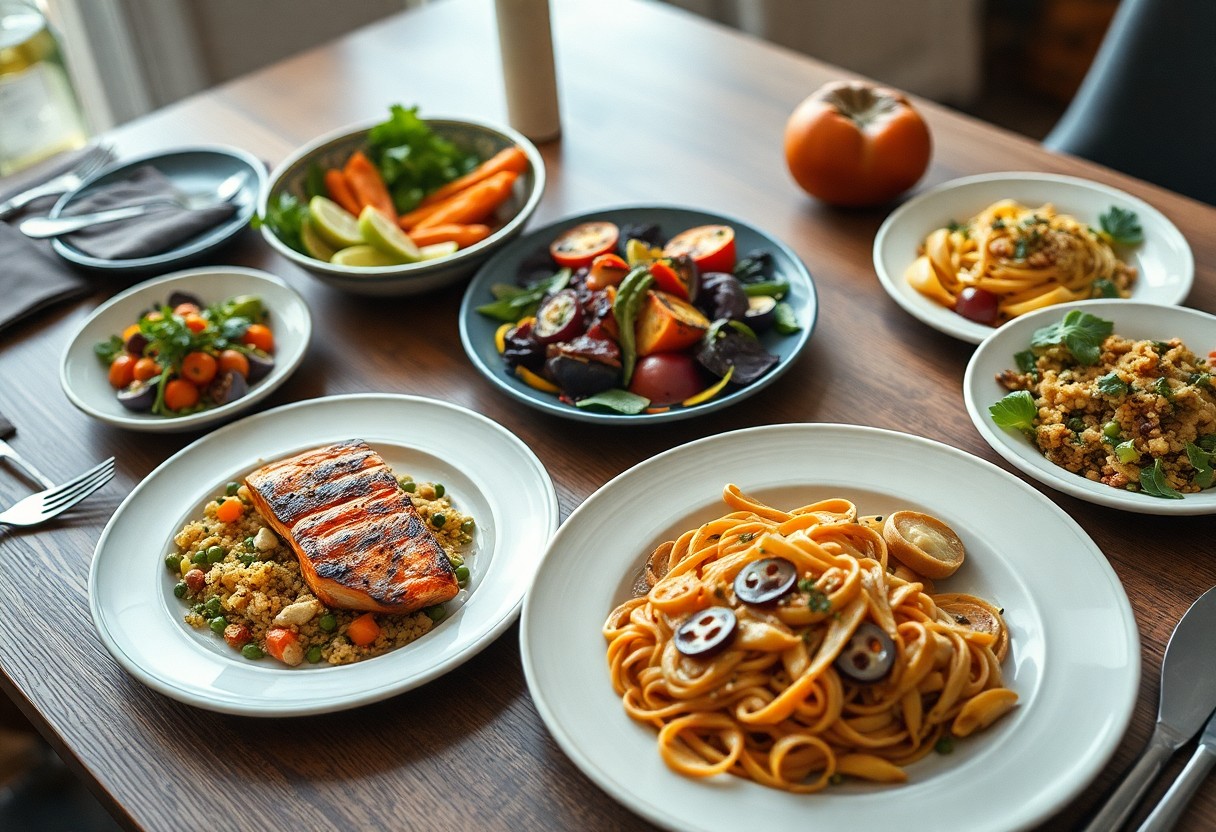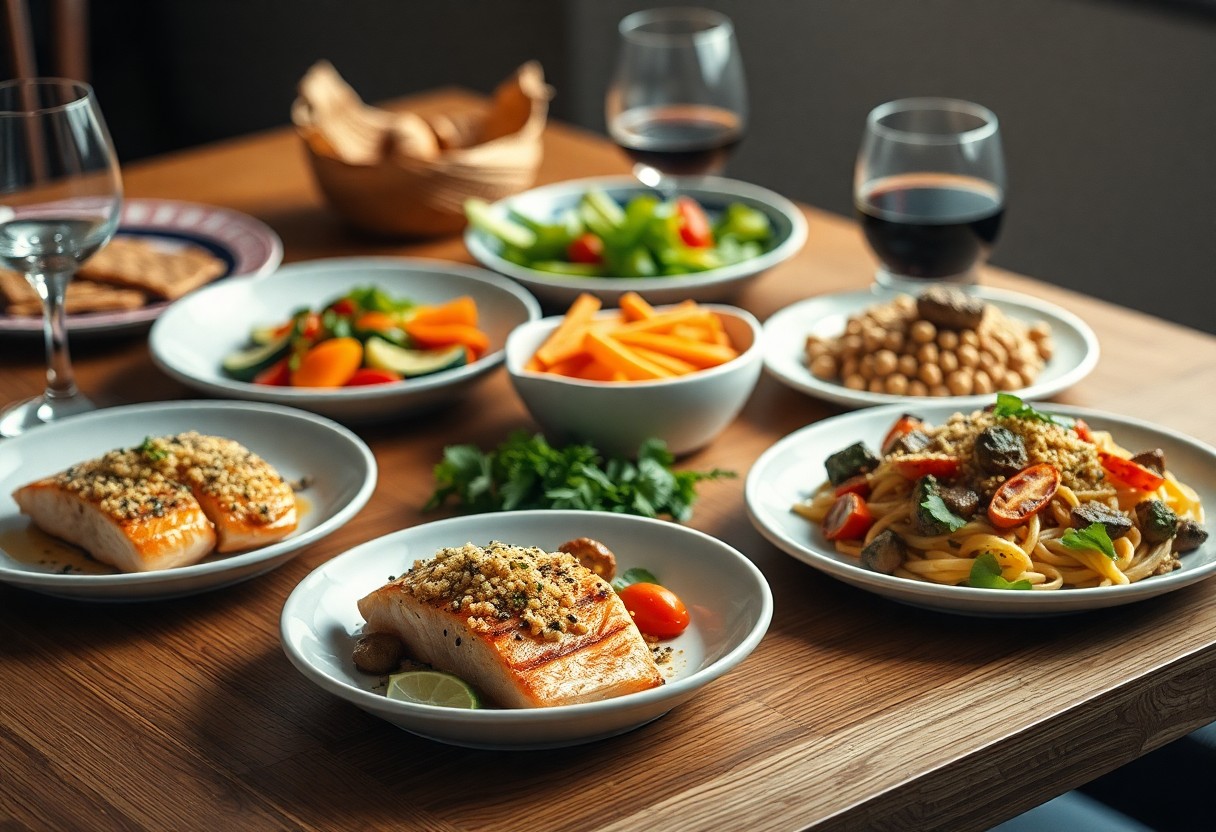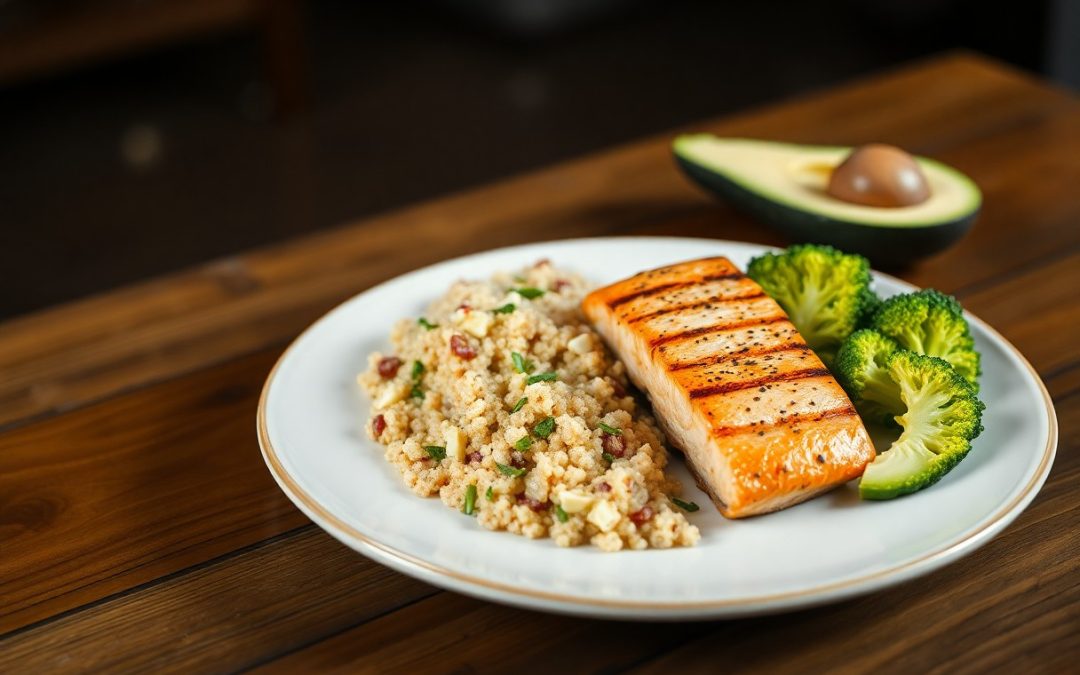Recipes designed for managing type 2 diabetes can help you maintain balanced blood sugar levels while enjoying your meals. By focusing on meals that are low in carbs and rich in lean protein and nonstarchy vegetables, you support your body’s needs without sacrificing flavor. These 13 diabetes-friendly dinner recipes provide nutrient-dense options that fit seamlessly into your diet. With these choices, you can reduce the risk of blood sugar spikes and promote satiety, making it easier to stick to your healthy diet and lifestyle goals.
Crafting Balanced Plates for Optimal Health
Designing your plate with precision can transform mealtime into a powerful tool for blood sugar management. Dividing it into quarters—one for lean protein, one for carbohydrates, and half for nonstarchy vegetables—helps regulate glucose while maximizing nutrient intake and satiety. This balanced approach supports steady energy levels and reduces the temptation to overeat, making it easier for you to stay on track with your health goals without sacrificing taste or variety.
The Importance of Macronutrients
Carbohydrates, proteins, and fats each play a distinct role in managing type 2 diabetes. Carbs, limited to about a quarter of your plate, provide energy but impact blood sugar directly, so focusing on fiber-rich, low-glycemic options becomes key. Lean proteins stabilize blood sugar and promote muscle health, while healthy fats support heart health—particularly important since diabetes increases cardiovascular risk. Balancing these macronutrients helps you maintain better glucose control and overall metabolic health.
Portion Control Strategies
Controlling portion sizes keeps calorie and carbohydrate intake in check, preventing blood sugar spikes. Using smaller plates, measuring serving sizes, and following recommended portions—like the quarter-plate carb guideline—allow you to enjoy a variety of foods without overconsuming. Visual cues, such as filling half your plate with colorful nonstarchy vegetables, naturally reduce calorie density while boosting fiber, which aids digestion and satiety.
Delving deeper, portion control can extend beyond just plate composition. Pre-portioning meals or snacks into containers helps avoid mindless eating, especially when faced with tempting high-carb or sugary foods. Pairing portions with regular meal timing stabilizes insulin response throughout the day. Tracking servings using simple methods like the hand guide—palm-sized protein, fist-sized vegetables, cupped hand for carbs—can simplify adherence. Incorporating mindful eating practices, such as slowing down and savoring each bite, further aids awareness of fullness cues, reducing the risk of overeating and supporting better long-term glucose management.

Delectable Dinner Recipes
The selection of diabetes-friendly dinners here offers a variety of flavorful, nutrient-dense options that fit neatly into your balanced meal plan. Each recipe emphasizes appropriate carb portions, lean proteins, and plenty of nonstarchy vegetables, helping you manage blood sugar without sacrificing satisfaction. From hearty soups to grilled seafood, the choices demonstrate that tasty meals can align with your health goals. These dishes provide vital fiber, protein, and healthy fats, supporting steady energy levels and fullness throughout your evening.
Flavorful Low-Carb Entrées
Dishes like the Mediterranean Grilled Salmon Kabobs and Low-Carb Zucchini Lasagna showcase how you can enjoy rich flavors while keeping carbs in check. For instance, the salmon kabobs offer over 30 grams of protein and just 4.3 grams of carbs per serving, paired with nonstarchy veggies marinated in olive oil and spices. Similarly, the zucchini lasagna reduces saturated fat by using extra-lean beef and limited cheese, delivering 30 grams of protein with only 12 grams of carbs. These low-carb entrées are filling, satisfying, and designed with blood sugar balance in mind.
Wholesome Vegetarian Options
Vegetarian meals such as the Lentil Tacos and Cauliflower Tacos bring a nutrient-packed punch while supporting your dietary needs. Lentils provide significant protein, fiber, iron, and magnesium, making them an excellent plant-based protein source with just 2 grams of fat and 10 grams of fiber per serving. The cauliflower tacos incorporate nonstarchy roasted veggies and heart-healthy olive oil, combined with avocado lime sauce for added protein and healthy fats. Using whole wheat or corn tortillas—or even lettuce wraps—in these recipes helps keep carb intake moderate and adds extra fiber.
Focusing on vegetarian options can expand your meal variety while maintaining balanced diet choices. These recipes are thoughtfully crafted to maximize plant-based proteins and fiber, which support blood sugar control and promote satiety. Adding simple sides like black or pinto beans increases protein further without complicating preparation or increasing unhealthy fats. Whether you choose lentil-filled tacos or roasted cauliflower wrapped in tortillas, these options deliver wholesome nutrition and bold flavors that complement your diabetes-friendly diet plan.
Satisfying Sides That Elevate Meals
Complementing your main dishes with the right sides can significantly improve meal satisfaction without tipping your blood sugar out of balance. Focusing on nutrient-dense, low-carb options will help keep your plate colorful and your hunger at bay. Whether you choose crunchy nonstarchy veggies or innovative carb alternatives, these sides bring texture, flavor, and fullness to your diabetes-friendly dinners.
Nonstarchy Vegetable Serve-alongs
Nonstarchy vegetables like asparagus, zucchini, broccoli, and leafy greens are excellent side options packed with fiber, vitamins, and minerals while remaining low in digestible carbohydrates. You can steam, roast, or sauté them in heart-healthy oils, such as olive oil, to add flavor without added carbs. Plus, their fiber content helps slow glucose absorption, promoting steadier blood sugar levels.
Creative Carb Swaps
Swapping traditional carb-heavy sides with creative, lower-carb alternatives can make a big difference in managing your carbohydrate intake. Try cauliflower rice instead of white rice, zucchini noodles in place of pasta, or quinoa crusts instead of traditional pizza bases. These swaps offer fiber and nutrients, helping control the glycemic load of your meals without sacrificing texture or enjoyment.
Beyond just swapping ingredients, these creative carb alternatives often come with added nutritional benefits. Cauliflower, for example, provides vitamin C and folate, while quinoa packs a complete protein profile with magnesium and iron. Using these alternatives also reduces your intake of highly processed carbs, which tend to cause quick blood sugar spikes. Integrating these smarter carbs consistently supports a balanced diet that aligns with your glucose management goals and keeps meals enjoyable.

Cooking Techniques to Embrace and Avoid
Choosing the right cooking techniques can transform your meals into diabetes-friendly dishes without sacrificing flavor. Favor methods that preserve nutrients and limit added fats or sugars. Techniques like grilling, roasting, steaming, and sautéing with minimal oil maintain the integrity of ingredients while keeping calorie and carb counts in check. Conversely, deep frying or heavy breading can introduce excess saturated fats and carbs, which may spike blood sugar and negatively impact heart health. By swapping frying for these healthier alternatives, you’ll enjoy satisfying meals aligned with your blood sugar goals.
Healthier Preparation Methods
Steaming or roasting vegetables locks in vitamins and fiber which support glucose control. When cooking proteins, opt for grilling, baking, or poaching rather than frying to reduce added fat. Using heart-healthy oils such as olive or avocado oil in moderation adds beneficial fats without overwhelming calories. Incorporate slow cooking or pressure cooking for tender meals that require little added fat. Small adjustments, like replacing white rice with cauliflower rice or spiralized zucchini, can significantly cut carbs while boosting nutrient content.
Ingredients to Reduce
Lowering saturated fats, refined carbs, and added sugars in your recipes helps stabilize blood sugar and promotes heart health. Ingredients like white flour, sugary sauces, fatty cuts of meat, and full-fat dairy increase calorie density without offering much nutritional benefit. Reducing sodium by choosing low-sodium condiments protects blood pressure, another key factor in diabetes management. Choosing whole food ingredients over processed options limits hidden sugars and unhealthy fats that sabotage your efforts.
Refined grains like white bread and pasta rapidly elevate blood glucose, making whole grains or vegetable substitutes wiser choices. Added sugars in condiments, sauces, and dressings contribute to unnecessary carb loads; swappable options include herbs, spices, or vinegar-based dressings. Saturated fats found in fatty meats and cheeses raise cardiovascular risks common in diabetes – lean proteins and modest cheese use help control this. Also, watch your sodium intake by choosing low-sodium broths and soy sauce alternatives to reduce hypertension risk. By curbing these ingredients, your meals stay flavorful yet balanced for your health.
Summing up
Ultimately, these 13 diabetes-friendly dinner recipes offer you diverse, flavorful options that help support your blood sugar management and satisfy your appetite. By focusing on balanced portions of lean protein, healthy fats, and nonstarchy vegetables, you can enjoy meals that suit your lifestyle without compromising taste. Incorporating these dishes into your diet empowers you to take control of your health with confidence and variety, making it easier to maintain your nutritional goals every day.
FAQ
Q: How can these 13 diabetes-friendly dinner recipes help manage blood sugar levels?
A: These recipes are designed to balance carbohydrates, lean proteins, and nonstarchy vegetables in a way that supports stable blood sugar control. For example, many meals emphasize using low-carb ingredients like zucchini noodles or cauliflower as alternatives to traditional high-carb items. Incorporating fiber-rich foods such as lentils, quinoa, and nonstarchy veggies also helps slow glucose absorption, contributing to better blood sugar management as part of an overall diet.
Q: Are these recipes suitable for someone who is new to cooking with type 2 diabetes in mind?
A: Yes, these recipes are straightforward and flavorful, making them approachable for people new to diabetes-friendly cooking. They offer practical swaps, like using lean proteins, low-sodium sauces, and whole grain or vegetable-based alternatives to higher carb or fried options. This approach helps build a sustainable and enjoyable diet that supports long-term health.
Q: Can these diabetes-friendly recipes accommodate vegetarian or plant-based preferences?
A: Absolutely. Several recipes on the list are vegetarian or easily adaptable with plant-based proteins. For instance, the vegetarian lentil tacos and cauliflower tacos use nutrient-dense legumes and vegetables to provide protein and fiber. Additionally, options like the Easy Quinoa Salad and No-Cook Zucchini Noodles with Pesto can be enhanced with tofu or other plant-based proteins, fitting well into a balanced diet.


